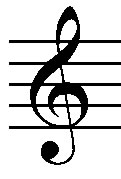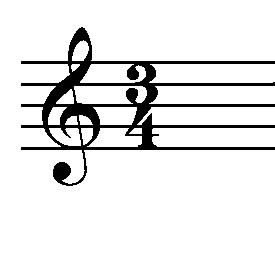Many centuries ago the staff had eleven lines. The center line was removed to create the treble and bass clefs we know today.
We are going to use the treble clef  and bass clef
and bass clef 

If you look carefully, you will see that the notes go in alphabetical order. You can think of the lowest line of the bass clef as being the "Ground floor" and say the alphabet for every line and space.
Another way to remember the names if the lines and spaces is by remembering some reminder sentences
For the treble staff:


A time signature tells you two things about the music.
 |
1. The top numbers tells you: How many beats are grouped together. 2. The bottom number tells you: What kind of note will be equal to one beat. |
|---|
The time signature above tells you that there will be 3 beats in a measure and a quarter note will get 1 beat.
You can practice all of these things by using MUSIC ACE on the computer in the computer lab or the library. Complete the lessons, play the games and spend some time with "Doodle Pad"!